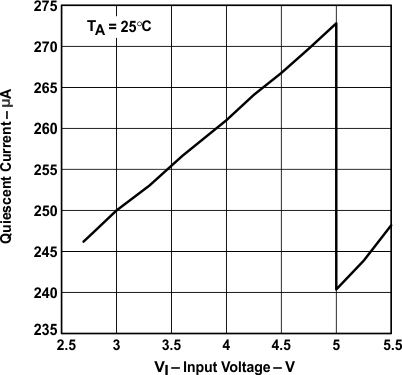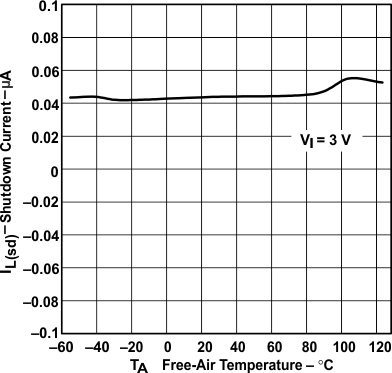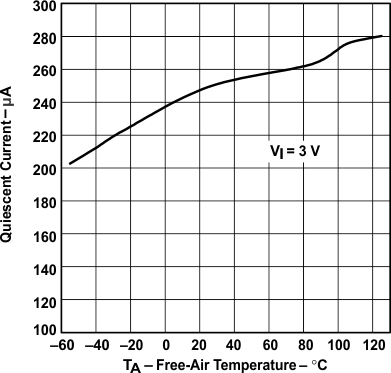SLVS372C June 2001 – October 2015 TPS60240 , TPS60241 , TPS60242 , TPS60243
PRODUCTION DATA.
- 1 Features
- 2 Applications
- 3 Description
- 4 Revision History
- 5 Pin Configuration and Functions
- 6 Specifications
- 7 Detailed Description
- 8 Application and Implementation
- 9 Power Supply Recommendations
- 10Layout
- 11Device and Documentation Support
- 12Mechanical, Packaging, and Orderable Information
Package Options
Refer to the PDF data sheet for device specific package drawings
Mechanical Data (Package|Pins)
- DGK|8
Thermal pad, mechanical data (Package|Pins)
Orderable Information
6 Specifications
6.1 Absolute Maximum Ratings
Over operating free-air temperature range (unless otherwise noted) (1)| MIN | MAX | UNIT | ||
|---|---|---|---|---|
| VDD | Supply voltage | –0.3 | 6 | V |
| PD | Power dissipation | Internally limited | ||
| Voltage EN | –0.3 | 6 | V | |
| Voltage C2–, C1– | –0.3 | VIN or 5.5(2) | V | |
| Voltage C2+, C1+ | –0.3 | VIN, VOUT, or 5.5(2) | V | |
| TJ | Junction temperature | 125 | °C | |
| Short circuit output current | 80 | mA | ||
| Tstg | Storage temperature | –65 | 150 | °C |
(1) Stresses beyond those listed under Absolute Maximum Ratings may cause permanent damage to the device. These are stress ratings only, which do not imply functional operation of the device at these or any other conditions beyond those indicated under Recommended Operating Conditions. Exposure to absolute-maximum-rated conditions for extended periods may affect device reliability.
(2) Whichever is lowest.
6.2 ESD Ratings
| VALUE | UNIT | |||
|---|---|---|---|---|
| V(ESD) | Electrostatic discharge | Human body model (HBM), per ANSI/ESDA/JEDEC JS-001(1) | ±2000 | V |
| Charged-device model (CDM), per JEDEC specification JESD22-C101(2) | ±500 | |||
(1) JEDEC document JEP155 states that 500-V HBM allows safe manufacturing with a standard ESD control process.
(2) JEDEC document JEP157 states that 250-V CDM allows safe manufacturing with a standard ESD control process.
6.3 Recommended Operating Conditions
Over operating free-air temperature range (unless otherwise noted)| MIN | NOM | MAX | UNIT | |||
|---|---|---|---|---|---|---|
| VIN | Input voltage | TPS60240, TPS60242, TPS60243 | 1.8 | 5.5 | V | |
| TPS60241 | 2.7 | 5.5 | ||||
| IOUT | Output current | All devices | 25 | mA | ||
| CIN | Input capacitor | 1 | µF | |||
| C1, C2 | Flying capacitors | 1 | µF | |||
| COUT | Output capacitor | 1 | µF | |||
| TA | Operating temperature | –40 | 85 | °C | ||
6.4 Thermal Information
| THERMAL METRIC(1) | TPS6024x | UNIT | |
|---|---|---|---|
| DGK (VSSOP) | |||
| 8 PINS | |||
| RθJA | Junction-to-ambient thermal resistance | 174 | °C/W |
| RθJC(top) | Junction-to-case (top) thermal resistance | 66 | °C/W |
| RθJB | Junction-to-board thermal resistance | 95 | °C/W |
| ψJT | Junction-to-top characterization parameter | 8.8 | °C/W |
| ψJB | Junction-to-board characterization parameter | 94 | °C/W |
| RθJC(bot) | Junction-to-case (bottom) thermal resistance | n/a | °C/W |
(1) For more information about traditional and new thermal metrics, see the Semiconductor and IC Package Thermal Metrics application report, SPRA953.
6.5 Electrical Characteristics
For TPS6024x at TA = 25°C, CIN = COUT =1 µF, C1 = C2 = 1 µF (unless otherwise noted), limits apply over the specified temperature range, –40°C to 85°C.| PARAMETER | TEST CONDITIONS | MIN | TYP | MAX | UNIT | |||
|---|---|---|---|---|---|---|---|---|
| VIN | Input voltage | TPS60240 assured start-up | IOUT ≤ 5 mA, RL = 600 Ω | 1.8 | 5.5 | V | ||
| TPS60241 assured start-up | IOUT ≤ 12 mA, RL = 417 Ω | 2.7 | 5.5 | |||||
| TPS60242 assured start-up | IOUT ≤ 12 mA, RL = 225 Ω | 1.8 | 5.5 | |||||
| TPS60243 assured start-up | IOUT ≤ 10 mA, RL = 300 Ω | 1.8 | 5.5 | |||||
| VOUT | Output voltage | TPS60240 | 1.8 V ≤ VIN ≤ 5.5 V, 0 mA ≤ IOUT ≤ 5 mA | 3.2175 | 3.3 | 3.3825 | V | |
| 2.4 V ≤ VIN ≤ 5.5 V, 0 mA ≤ IOUT ≤ 25 mA | 3.2175 | 3.3 | 3.3825 | |||||
| TPS60241 | 2.7 V ≤ VIN ≤ 5.5 V, 0 mA ≤ IOUT ≤ 12 mA | 4.875 | 5 | 5.125 | ||||
| 3 V ≤ VIN ≤ 5.5 V, 0 mA ≤ IOUT ≤ 25 mA | 4.875 | 5 | 5.125 | |||||
| TPS60242 | 1.8 V ≤ VIN ≤ 5.5 V, 0 mA ≤ IOUT ≤ 12 mA | 2.6325 | 2.7 | 2.7675 | ||||
| 2.3 V ≤ VIN ≤ 5.5 V, 0 mA ≤ IOUT ≤ 25 mA | 2.6325 | 2.7 | 2.7675 | |||||
| TPS60243 | 1.8 V ≤ VIN ≤ 5.5 V, 0 mA ≤ IOUT ≤ 10 mA | 2.925 | 3 | 3.075 | ||||
| 2.3 V ≤ VIN ≤ 5.5 V, 0 mA ≤ IOUT ≤ 25 mA | 2.925 | 3 | 3.075 | |||||
| IOUT | Output current | TPS60240/2/3 | Nominal | 2 V ≤ VIN ≤ 5.5 V | 12 | mA | ||
| Short circuit | VIN = 2 V | 80 | ||||||
| TPS60241 | Nominal | 2.7 V ≤ VIN ≤ 5.5 V | 12 | |||||
| Short circuit | VIN = 3.25 V | 80 | ||||||
| fOSC | Internal clock source | 100 | 160 | 300 | kHz | |||
| Vn | Output noise voltage | TPS60240/2/3 | VIN < 2.5 V, IOUT = 5 mA, ESR < 0.1 Ω, Measured over 20 Hz to 10 MHz, COUT = 4.7 µF |
170 | µV RMS | |||
| TPS60241 | VIN = 2.7 V, IOUT = 5 mA, ESR < 0.1 Ω, Measured over 20 Hz to 10 MHz, COUT = 4.7 µF |
170 | ||||||
| VIH | Logic high input voltage, EN | 1.3 | 5.5 | V | ||||
| VIL | Logic low input voltage, EN | –0.2 | 0.4 | V | ||||
| IIH | Logic high input current, EN | 100 | nA | |||||
| IIL | Logic low input current, EN | 100 | nA | |||||
| t(EN) | Start-up time, EN | VOUT > 90% of V(NOM), 0.1 mA ≤ IOUT ≤ 10 mA, COUT = 1 µF | 0.5 | ms | ||||
| η | Efficiency | TPS60240 | IOUT = 5 mA, VIN = 1.8 V | 89.6% | ||||
| TPS60241 | IOUT = 10 mA, VIN = 2.7 V | 90.8% | ||||||
| TPS60242 | IOUT = 10 mA, VIN = 1.8 V | 73% | ||||||
| TPS60243 | IOUT = 10 mA, VIN = 1.8 V | 81% | ||||||
| IQ | Quiescent current | IOUT = 0 mA, VIN = 3 V | 250 | 400 | µA | |||
| In shutdown mode | 0.1 | 1 | ||||||
| Thermal shutdown | Temperature activated | 160 | °C | |||||
| Temperature deactivated | 140 | |||||||
6.6 Typical Characteristics
 Figure 1. TPS60241
Figure 1. TPS60241 Quiescent Current vs Input Voltage
 Figure 3. TPS60241
Figure 3. TPS60241 Shutdown Current vs Free-Air Temperature
 Figure 2. TPS60241
Figure 2. TPS60241 Quiescent Current vs Free-Air Temperature